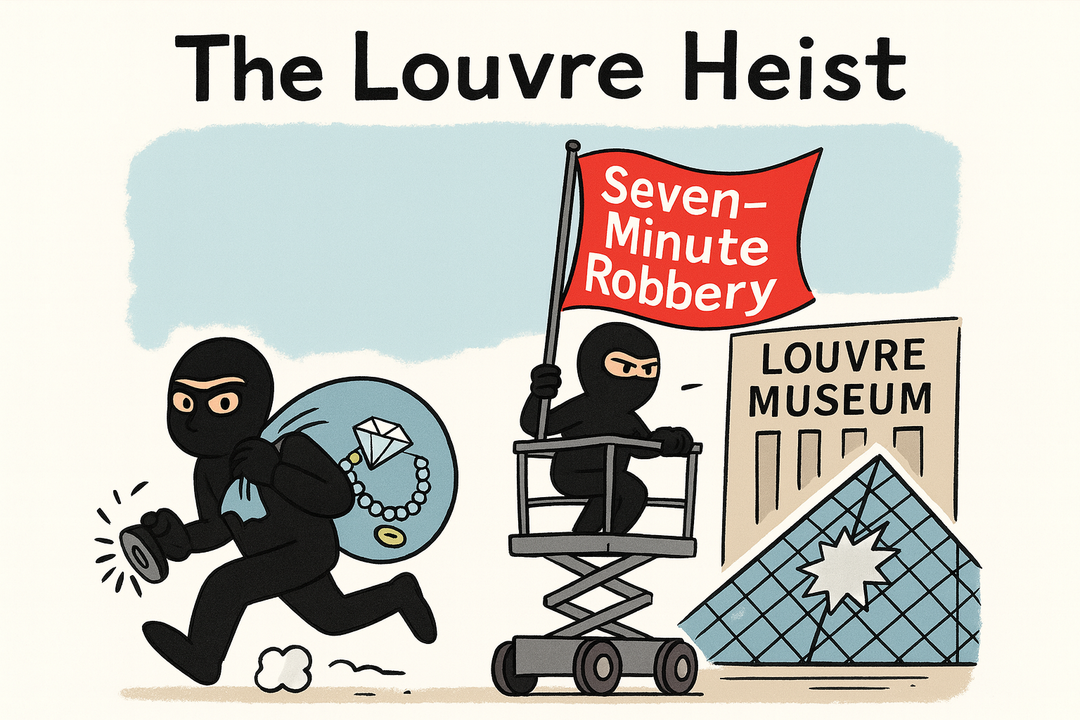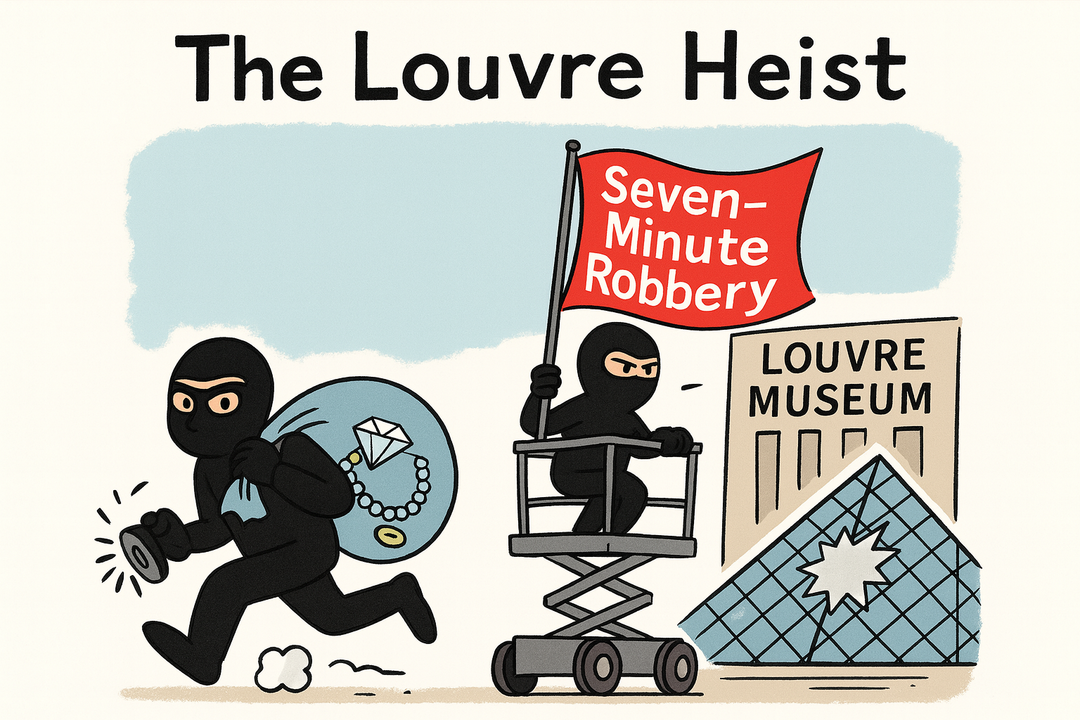Paris — Four masked thieves riding a basket-lift shattered a second-floor window of the Louvre’s Galerie d’Apollon around 9:30 a.m. on October 19, then smashed vitrines with power tools and fled in under eight minutes with Napoleonic jewels of “inestimable” value—dropping one emerald diadem as they escaped. France’s justice minister called it a “failure,” and investigators swiftly assigned a specialist robbery unit while the museum shut for security reviews. The Washington Post+3Reuters+3Reuters+3

Where the investigation stands
Police are hunting four suspects and probing organized-crime links; prosecutors confirmed a deployment of dozens of investigators. Officials acknowledged unsecured windows and unattended equipment as lines of inquiry, and the government ordered a nationwide audit of cultural-site protections. The Louvre remained closed the next day as security checks proceeded. Financial Times+2AP News+2
Experts warn the recovery clock is brutal: if police miss the first 24–48 hours, gems are often re-cut or precious metals melted, destroying historical identity and making recovery far harder. That risk profile fits this case, which targeted portable, high-value jewels rather than unique, unsellable canvases. People.com+1
If the thieves aren’t caught soon, what usually happens?
Disassembly and laundering. Reuters’ crime analysts note France may catch the thieves yet still fail to recover the jewels intact—because stones can be re-cut and reset, metals melted, and components sold piecemeal through opaque channels. Reuter
Long tail recoveries—rare, but real. Once items are listed on INTERPOL’s Stolen Works of Art database (and mirrored in the FBI’s National Stolen Art File), border checks, due-diligence by auction houses and dealers, and tip-offs can yield years-later recoveries—if distinctive features survive. 국제형사경찰기구+1
Policy ripple effects. Major heists usually trigger funding and staffing reviews; France’s government has already pledged security upgrades and a national protocol review. Reuters
This isn’t new: the modern playbook of “spectacle thefts”
Boston, 1990 (Isabella Stewart Gardner Museum): Two impostors posing as police tied up guards and stole 13 works (Rembrandt, Vermeer). Still unrecovered; the museum offers a $10 million reward, and the FBI calls it the largest property crime in U.S. history. Federal Bureau of Investigation+1
Dresden, 2019 (Green Vault): A jewel gang cut power and took diamond-studded 18th-century sets. Courts convicted several men in 2023; dozens of pieces were later recovered after negotiations tied to the trial. Artnet News+1|
Paris, 2010 (Museum of Modern Art): The “Spider-Man” burglar lifted five masterpieces after alarms failed; the works remain missing. Artsy
Rotterdam, 2012 (Kunsthal): Seven paintings by Picasso, Monet, Matisse vanished in two minutes; a suspect’s mother claimed to have burned the works (a point later disputed), underscoring how quickly evidence can be destroyed. The Guardian+1
Paris, 1911 (Mona Lisa): Stolen by a former Louvre worker and recovered in 1913; the global media frenzy helped supercharge the painting’s fame—a reminder that theft can transform cultural meaning. Encyclopedia Britannica+1
London, 2023 (British Museum): An alleged insider theft of some 2,000 small artifacts prompted resignations and a long recovery campaign—highlighting insider risk and inventory blind spots. Reuters+1
What’s different about the Louvre heist?
Speed + construction equipment. A crane/basket-lift and grinders enabled a seven-minute “smash-and-grab” on a historic facade—tactics more common to storefront robberies than encyclopedic museums. Reuters+1
Material value over art-market value. Experts suggest the target selection (sapphires, emeralds, diamonds) points to liquidation value, not collector demand—bad news for intact recovery odds. The Guardian
Systemic stress. The heist comes amid staff-shortage debates and renovation/modernization pressures in top museums handling record footfall. Officials now concede “we failed,” which usually precedes new funding and standards. Reuters
Likely next steps—and what to watch
Listings & border alerts. Expect rapid entry (if not already) into INTERPOL’s database and app-based alerts (ID-Art) used by customs and police; comparable systems aided later recoveries in Europe. 국제형사경찰기구+1
Forensic follow-through. Tool marks, vehicle forensics, mobile-tower pings, and CCTV stitching are standard; in Dresden, such evidence underpinned prosecutions even before all items resurfaced. Artnet News
Security retrofits. Expect glazing upgrades, window hardening, access-equipment controls, and alarm testing protocols across French institutions; ministers have already ordered a review. Reuters
Narrative battle. As with the Mona Lisa, public memory can reframe objects—and institutions. If recoveries fail, the story will pivot from patrimony to policy failure; if successful, to interagency cooperation. Encyclopedia Britannica
Bottom line
The Louvre robbery follows a familiar arc: a rapid, highly planned strike on portable, high-value heritage objects; a frantic first-48-hours chase; then a long tail in which prosecutions may outpace recoveries. Past cases show both outcomes: Boston’s masterpieces are still missing, while Dresden’s jewels largely came back after courtroom pressure. For Paris, the next few days likely decide whether this becomes a policy cautionary tale—or an eventual recovery story. gardnermuseum.org+1
SayArt.net
Jason Yim yimjongho1969@gmail.com









